Question
(a) One day a survey is taken of the ages of 120 children at a fairground.
The results are shown in the frequency table.
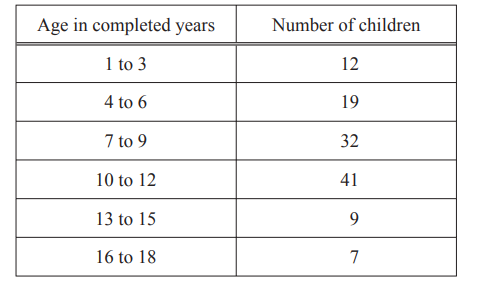
(i) On the grid, draw a bar chart for this data.
Complete the scale on the frequency axis.
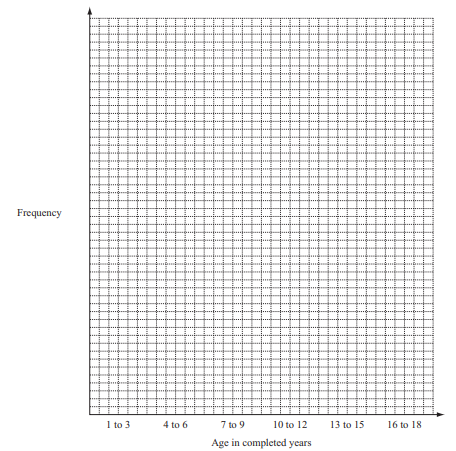
Answer/Explanation
Ans: Correct diagram with scale
(ii) What is the modal age group?
Answer/Explanation
Ans: 10 to 12 cao
(iii) One of the 120 children is chosen at random.
Write down the probability that the child is aged 4 to 6.
Answer/Explanation
Ans: \(\frac{19}{120}\) or 0.158[3….] or 15.8[3……]%
(b) Lalia says the probability of taking a yellow bead from a bag containing yellow beads and black beads is \(\frac{7}{5}.\)
Explain why \(\frac{7}{5}\) cannot be a correct probability
Answer/Explanation
Ans: Probability must be between 0 and 1 oe
(c) Another bag contains 9 green marbles and 11 red marbles.
A marble is taken at random.
Write down the probability that the marble is
(i) green,
Answer/Explanation
Ans: \(\frac{9}{20}\) or 0.45 or 45%
(ii) blue.
Answer/Explanation
Ans: 0 oe
Question
(a) 120 children take part in an athletics competition.
(i) Complete the table to show the number of children in each group.
| Girls | Boys | Total | |
| Age 15 | 65 | ||
| Age 16 | 44 | ||
| Total | 70 | 120 |
Answer/Explanation
Ans:
| Girls | Boys | Total | |
| Age 15 | 26 | 39 | 65 |
| Age 16 | 44 | 11 | 55 |
| Total | 70 | 50 | 120 |
(ii) One child is selected at random.
Find the probability that it is a girl aged 16.
Give your answer as a fraction in its lowest terms.
Answer/Explanation
Ans: \(\frac{11}{30}oe\)
(iii) Write down the ratio number of girls aged 15: number of boys aged 15.
Give your answer in its simplest form.
Answer/Explanation
Ans: 2 : 3 cao
(b) Here are the distances, in metres, recorded in the boys’ shot putt.
9.23 6.21 9.86 8.64 7.15 7.72 9.01 7.34 6.53 6.89
(i) Find the median.
Answer/Explanation
Ans: 7.53 m
(ii) Find the range.
Answer/Explanation
Ans: 3.65 m
(iii) Another boy was a late entry to the competition.
After his attempt, the range increased by 20cm.
Work out the two possible distances of his attempt.
Answer/Explanation
Ans: 10.06 m or 6.01 m
Question
(a) Bag A contains 20 counters.
6 are red, 9 are blue and the rest are white.
Jared takes one counter at random.
Write down the probability that the counter is
(i) red,
(ii) white,
(iii) yellow.
(b) Bag B contains green counters, black counters, purple counters and brown counters.
Louise takes one counter at random.
Complete the table.
(c) Bag C contains 8 red counters and 12 blue counters only.
Bag D contains 6 red counters and 9 blue counters only.
A counter is taken at random from each bag.
Show that the probability of taking a red counter from bag C is equal to the probability of taking a red
counter from bag D.
Answer/Explanation
Ans:
(a) (i) \(\frac{6}{20}\) oe
(ii) \(\frac{5}{20}\) oe
(iii) 0
(b) [0].28 oe
(c) \(\frac{8}{20}\)
\(\frac{6}{15}\)
Comparing the two fractions
with equal denominators or as
decimals
Question
Ten students each take two French tests.
Their marks are recorded in the table below.
(a) One of the ten students is chosen at random.
Find the probability that their mark on Test 2 is higher than their mark on Test 1.
(b) (i) Complete the scatter diagram.
The first six points have been plotted for you.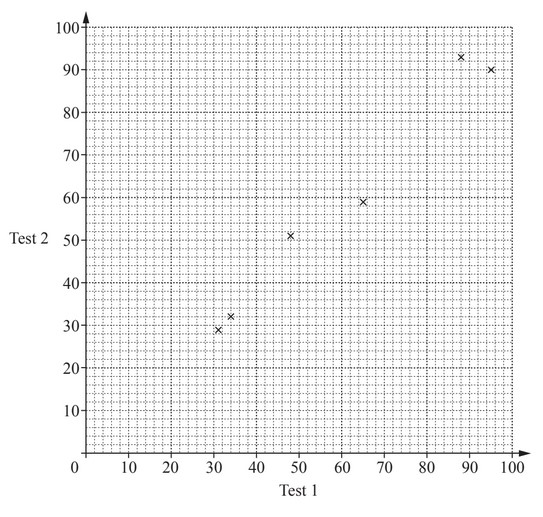
(ii) What type of correlation is shown on the scatter diagram?
(iii) On the grid, draw the line of best fit.
(iv) Another student scored 45 marks on Test 2.
Use your line of best fit to estimate the mark for this student on Test 1.
(v) A different student scored 10 marks on Test 1.
Explain why you should not use your scatter diagram to estimate their mark on Test 2.
Answer/Explanation
Ans:
(a) \(\frac{2}{10}\) oe
(b) (i) 4 points correctly plotted
(ii) positive
(iii) correct ruled line
(iv) 46 to 48
(v) 10 is not in range of recorded
test 1 results
Question
(a) A bag contains 5 white and 6 black marbles.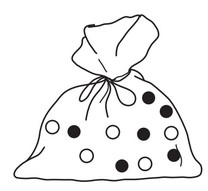
(i) A marble is chosen at random from the bag and then replaced.
Write down the probability that the marble is black.
(ii) Delilah adds some more black marbles to the bag.
The probability of choosing a black marble is now \(\frac{2}{3}\).
How many black marbles did she add to the bag?
(b) A white marble costs w cents and a black marble costs b cents.
(i) 2 white marbles and 5 black marbles cost 155 cents.
Complete the equation.
2w + 5b = …………….
(ii) 3 white marbles and 10 black marbles cost 290 cents.
Write down an equation to show this information.
(iii) Solve your two equations to find the value of w and the value of b.
You must show all your working.
w = ……………………………………
b = ……………………………………
(c) A black marble is weighed and its mass, m grams, is 35 g correct to the nearest 5g.
Complete the statement about the value of m.
…………………….. \(\leq m\) ,< …………………
(d) Each marble is a sphere of diameter 3cm.
On the grid, draw an accurate net of the smallest closed box a marble can fit in.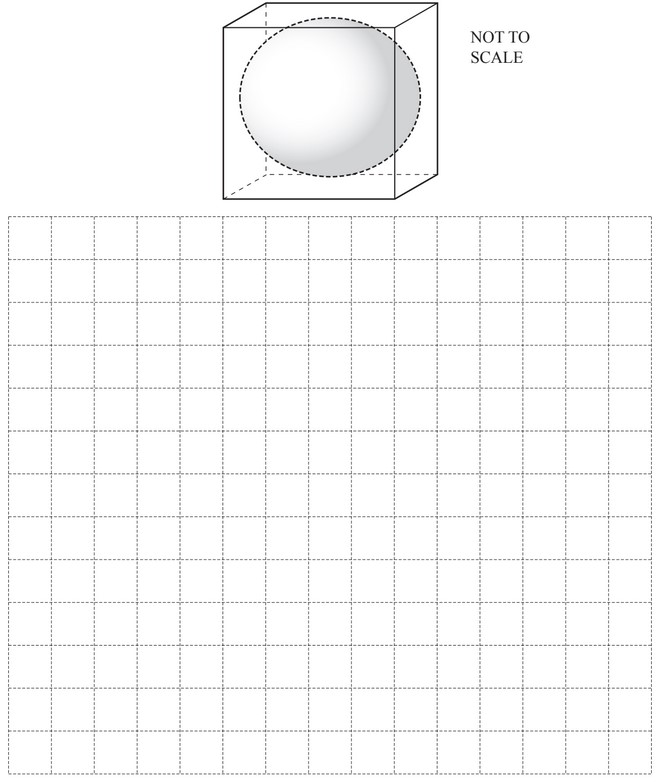
Answer/Explanation
Answer:
(a) (i) \(\frac{6}{11}\) oe
(ii) 4
(b) (i) 155
(ii) 3w + 10b = 290 oe
(iii) [w] 20
[b] 23
(c) 32.5, 37.5
(d) correct net
Question
(a) Jon spins this 6-sided spinner.
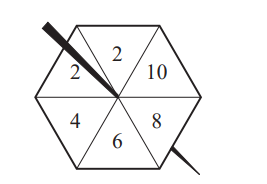
The probability that the spinner lands on any of the six sides is equally likely.
Write down the probability that the spinner lands on
(i) the number 6,
Answer/Explanation
Ans: \(\frac{1}{6}oe\)
(ii) a prime number,
Answer/Explanation
Ans: \(\frac{2}{6}oe\)
(iii) a number less than 11.
Answer/Explanation
Ans: 1
(b) Felix has a 12-sided spinner with the numbers 2, 4, 5, 7 and 9 written on it.
It is equally likely to land on any side.
The table shows the probability of the spinner landing on each number.

The diagram of the spinner has been completed for the number 2.
Complete the diagram for the numbers 4, 5, 7 and 9.
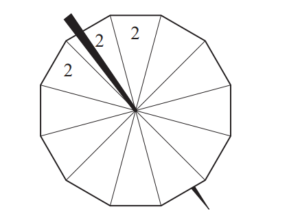
Answer/Explanation
Ans: (2,2,2), 4,4,4,4,5,5,7,7,9 seen on spinner
(c) Felix says that his spinner is more likely to land on a 2 than Jon’s spinner.
Explain why he is wrong.
Answer/Explanation
Ans: Felix’s probability is \(\frac{3}{12}\) which is
less than Jon’s probability \(\left (of\frac{2}{6} \right )\) which is \(\frac{4}{12}oe\)
(d) Felix spins his 12-sided spinner 60 times and records the results.
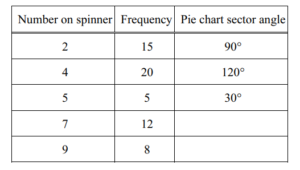
(i) Complete the table by working out the sector angles for the numbers 7 and 9 .
Answer/Explanation
Ans: (90°, 120°, 30°), 72°, 48°
(ii) Complete the pie chart.
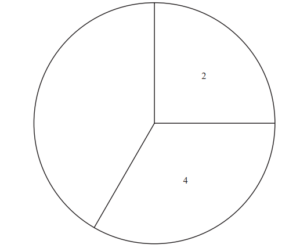
Answer/Explanation
Ans: 30° angle correct 72°, 48°
(iii) Write down the mode.
Answer/Explanation
Ans: 4
(iv) Calculate the mean.
Answer/Explanation
Ans: 4.85
